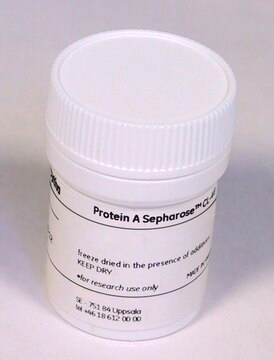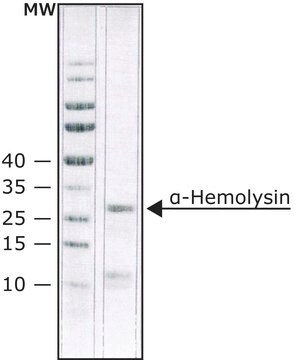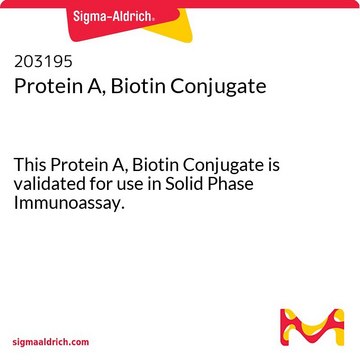P6031
Protein A from Staphylococcus aureus
Soluble, essentially salt-free, lyophilized powder, extracellular
Sinonimo/i:
Protein A resin
About This Item
Prodotti consigliati
Origine biologica
Staphylococcus aureus
Livello qualitativo
Coniugato
unconjugated
Forma fisica
essentially salt-free, lyophilized powder
Capacità
7-14 mg/mg, solid binding capacity (human IgG)
Solubilità
H2O: soluble 1 mg/mL, clear, colorless
N° accesso UniProt
Temperatura di conservazione
2-8°C
Informazioni sul gene
Staphylococcus aureus subsp. aureus NCTC 8325 ... SAOUHSC_00069(3919448)
Cerchi prodotti simili? Visita Guida al confronto tra prodotti
Descrizione generale
Applicazioni
- to coat nitrocellulose sheet with protein A for immunoassay of agalactosyl IgG.
- as a blocking agent before the use of secondary antibody in immunohistochemistry.
- as a binding agent to antibody during antibody immobilization.
Azioni biochim/fisiol
Protein A also participates in a number of different protective biological functions including anti-tumor, toxic, and carcinogenic activities. In addition to acting as an immunomodulator, it also has antifungal and antiparasitic properties.
Nota sulla preparazione
Esclusione di responsabilità
Codice della classe di stoccaggio
11 - Combustible Solids
Classe di pericolosità dell'acqua (WGK)
WGK 3
Punto d’infiammabilità (°F)
Not applicable
Punto d’infiammabilità (°C)
Not applicable
Dispositivi di protezione individuale
Eyeshields, Gloves, type N95 (US)
Certificati d'analisi (COA)
Cerca il Certificati d'analisi (COA) digitando il numero di lotto/batch corrispondente. I numeri di lotto o di batch sono stampati sull'etichetta dei prodotti dopo la parola ‘Lotto’ o ‘Batch’.
Possiedi già questo prodotto?
I documenti relativi ai prodotti acquistati recentemente sono disponibili nell’Archivio dei documenti.
I clienti hanno visto anche
Il team dei nostri ricercatori vanta grande esperienza in tutte le aree della ricerca quali Life Science, scienza dei materiali, sintesi chimica, cromatografia, discipline analitiche, ecc..
Contatta l'Assistenza Tecnica.










